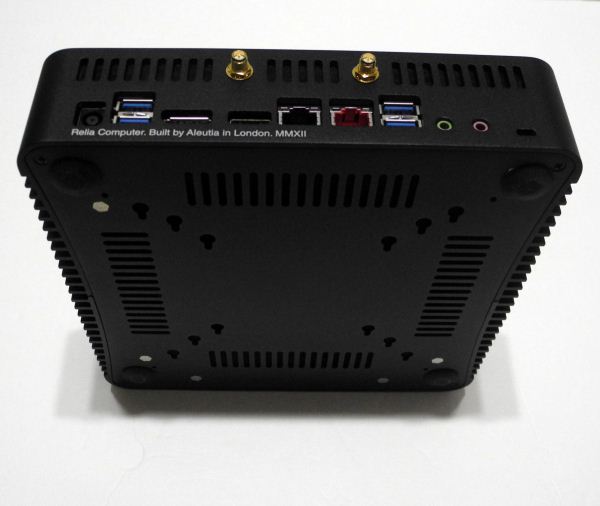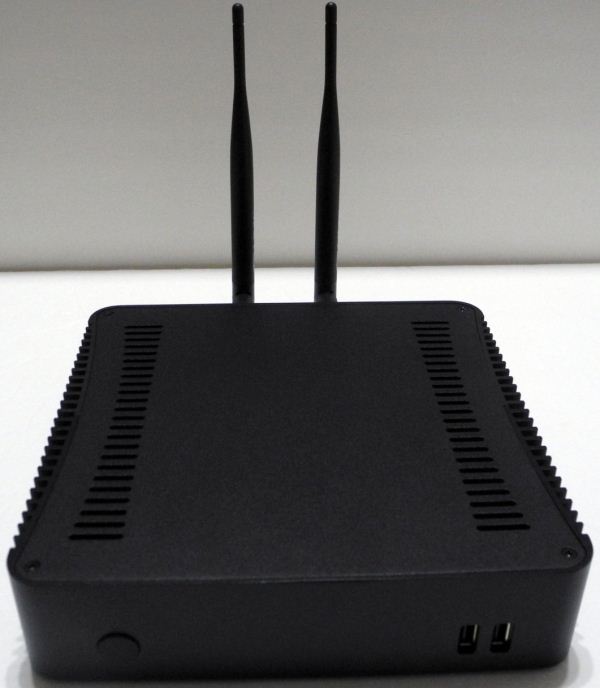Aleutia Relia Industrial PC Review: Ivy Bridge & Q77 in a Fanless Chassis
by Ganesh T S on December 4, 2012 10:00 AM EST- Posted in
- Industrial PC
- HTPC
- Ivy Bridge
- Aleutia
Unboxing and Setup Impressions:
Aleutia doesn't bundle input accessories (keyboard / mouse / IR remote etc.) with the system. We also don't find any detailed operating manuals. The package is pretty barebones as it can be. This is perfectly acceptable given the target market. There is a single welcome note which lists the package contents and also provides the initial login details for systems with pre-installed operating systems.
The contents of the package include:
- 90W AC adapter (with country-specific power plug)
- Driver and software CD from Intel for the DQ77KB motherboard
- OEM Windows 7 Home Premium installation DVD
- HDMI to DVI adapter
- Two TP-Link 2.4 GHz 802.11b/g/n compatible antennae
- Main unit
One of the most interesting aspects of the package is the main unit itself. The chassis is solidly built and meant to act as a giant heat sink. The industrial design is extremely pleasing to the eye. The rounded corners and the curved heat sink base on either side add to the aesthetics.
We would have liked the rubber feet at the bottom of the unit to be thicker in order to give more clearance to the ventilation slots at the bottom. A number of screw slots for mounts of varying sizes is also provided. The rear panel of the unit has the DC-in jack, four USB 3.0 ports, a full-size Display Port output as well as HDMI, two GbE LAN ports, analog audio out and microphone jacks and a Kensington lock slot. On the top side of the rear panel, we have ventilation slots interrupted in two places by Wi-Fi antenna holders.
The front panel is relatively bare, with a single power button and an LED indicator (which lights up blue when the system is powered up) on one side and two USB 2.0 ports on the other.
The top cover has ventilation slots running on either side close to the heat sink base. All the ventilation slots are covered by a thin gauzelike layer underneath which provides a certain degree of protection against internal dust build up.
Our review unit came with a pre-installed copy of Windows 7 Home Premium x64. Fortunately, there was no bloatware to uninstall. All our benchmarking programs were installed fresh. LAV Filters 0.52 and madVR 0.81 were used to test out the HTPC aspects in conjunction with MPC-HC v1.6.4.6052. Since the system has no in-built optical drive, we didn't have to worry about Blu-ray playback software.
We conclude this section with a summary of the data and A/V connectivity options for the Aleutia Relia review unit.
| Option | Status |
|---|---|
| HDMI | Yes [v1.4a] |
| Display Port | Yes |
| Component | No |
| Composite | No |
| VGA | Yes |
| SPDIF | Yes [Optical] |
| Stereo | Yes |
| Option | Status |
|---|---|
| Optical Disk Drive | No (DVD Slimline Drive Optional) |
| USB | Yes [4 x v3.0, 2 x v2.0] |
| eSATA | No |
| LAN | Yes [ 2 x 1000 Mbps GbE ] |
| Internal HDD | Yes [ 2 x 500 GB ] |
| Internal SSD | Yes [ 128 GB mSATA ] |
| WiFi | Yes [ 300 Mbps 1T2R 802.11b/g/n (Single band)] |
| Bluetooth | No |
| Card Reader | No |













47 Comments
View All Comments
Guspaz - Tuesday, December 4, 2012 - link
The only thing that makes it an "industrial PC" is that it's fanless. But there's no real difference from just taking any off-the-shelf fanless mini ITX case and slapping the "industrial" label on it. Adding a word to the name doesn't justify the massive markup.This isn't an Apple product, they can't justify that kind of premium.
Minion4Hire - Wednesday, December 5, 2012 - link
What fanless off-the-shelf mITX chassis includes VESA mounts and this small of a form factor? You can't buy this chassis from Streacom, and I certainly don't know of any other cases in this form factor that handle this level of hardware.This is most definitely a premium on industrial products. It might only be because it's a niche product that not a lot of people may require (relative to typical desktops, laptops, and other typical end-user devices) but it's more than justifiable. This is not for the average consumer.
Guspaz - Wednesday, December 5, 2012 - link
A bit of quick googling turned up Asaka's Euler, which does exactly this (IvyBridge Q77) at up to 35w. I really doubt there isn't any similar case that doesn't take that up to 45w, considering the Euler is much smaller than the Relia reviewed here, and as such simply has less surface area for cooling.Regardless, what you seem to be saying is that the slightly custom chassis is the only reason this device can justify a price 50%+ higher than already inflated retail pricing?
hobbesmaster - Monday, December 10, 2012 - link
I deploy stuff to industrial environments, this thing isn't even IP54 let alone IP 65 or 67 so its not exactly useful for me at least.twtech - Tuesday, December 4, 2012 - link
This product is not intended for HTPC use. I believe it was tested the way for the sake of having some reference point in performance analysis, because Anandtech is not a site specialized to industrial uses.Maybe you have never been in an industrial environment and so you don't know what that means. They tend to be very dusty. Active cooling will draw that dust into the system and it will collect there very quickly. Even if you have good fan filtering, that just means the filters will get clogged up very quickly.
That's why they went with passive cooling here and a more rugged chassis. That's also why it costs more.
mrdude - Tuesday, December 4, 2012 - link
Ah, my mistake.The review doesn't state its purpose until the final page, and even then that doesn't really explain why it's utilizing the weak WiFi and lack of Bluetooth, allowing the device to be neatly tucked away with a peripheral M+KB and display away from the unit.
I still don't get why they've gutted it of some features. If you don't need WiFi, then there's really no point in offering it. If you do then why opt with such a weak card?
QChronoD - Tuesday, December 4, 2012 - link
It says right in the title that its an Industrial Fanless PC. And I really doubt that if the was really going to be installed in some factory or what-not, that the company would be very enthusiastic about using all wireless peripherals. That's just a complication that they don't want to have to worry about (dead batteries/unpaired devices). Chances are they would be more than willing to run an ethernet cable to the location if there isn't already one.Personally, if I was buying this for a company, I'd option it with the lowest CPU, just the SSD, and not even bother with wireless. It sounds like the faster CPUs can't even run full speed for more than a few minutes. I would love to see Anandtech swap out the CPU for a much cooler i3 and run both configurations with a long test in the temperature chamber. If the i3 can run cool enough to not throttle, it could end up being faster than the i7.
FATCamaro - Tuesday, December 4, 2012 - link
Why buy this joke of a system over a mac miniA5 - Wednesday, December 5, 2012 - link
Completely different market. Did you read any of the other comments?ganeshts - Tuesday, December 4, 2012 - link
The chassis is custom made. There is a premium for fanless systems